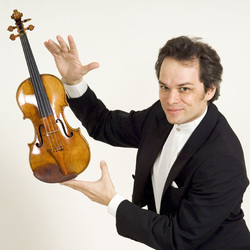
Austrian violinist Benjamin Schmid will be in Houston this week, for a return engagement with the Houston Symphony. And when he steps off the plane, he’ll be carrying something very special.
Along with clean socks and underwear, Schmid is bringing a Stradivarius violin, made in 1731 – and worth between $4 and $5 million dollars. This is the instrument he’ll use to play works by Felix Mendelssohn and Fritz Kreisler on Thursday, Saturday and Sunday at Jones Hall.
“It’s like a fairy-tale come true,” he declares, from his home in Salzburg, Austria, “because it’s one of the very finest Stradivarius instruments around.”
Schmid has had the instrument in his possession for about a decade. And he’s developed a relationship with it so complex and personal that it’s become almost human to him. Indeed, he talks about his instrument – known as the “Lady Jeanne” Strad – in terms that might make his wife (the pianist Ariane Haering) jealous.
“It’s actually easier to play,” he continues, “than some Strads I’ve had in my hands before. Sometimes Strads want to be played in a certain way – and it’s not necessarily the way you want to play them. They can be capricious. With this instrument, I clicked from the first moment – I’ve always felt we understand one another. It’s a very generous, full bodied instrument.”
Schmid goes on to explain that he discovered the instrument in a music shop in England. Fortunately, he had a friend who could help him out with the purchase: the American philanthropist Donald Hahn, who lives in Salzburg.
“I’ve known him since the 1980s,” he explains. “Ten years ago, I suggested he should buy an old Italian instrument as an investment. Then I came across the instrument in London, when I played at Wigmore Hall. Three weeks later, he bought it. It belongs to his trust fund, not to me, but I’m glad I can play it.”
There are about 600 violins built by Antonio Stradivari known to exist today – plus about 50 Strad cellos and a dozen violas. They’re scattered all over the world, and many are in the hands of top-ranked soloists, such as Schmid.
In Houston, violinist Cho-Liang Lin, who teaches at Rice University, has a 1727 Strad. And violinist Fredell Lack, who taught at the University of Houston for many years, played a Strad throughout her career.
However, some Strads aren’t currently in the hands of musicians. They’ve become so highly prized by collectors that many are locked away in vaults. Over the years, they’ve proven to be excellent investments: unlike the stocks, bonds or real estate, they’ve never been known to depreciate.
As a result, Schmid’s situation – playing a fine instrument he doesn’t actually own – is not rare these days. While he’s grateful that he has one to use, he’s not happy that the instruments have been priced out of musicians’ reach.
“I hope not to offend anyone,” he begins, “but I don’t think it’s a good situation at all. There are almost no musicians in the world today who can buy these instruments. These instruments are the best in the world – and they should be played by the best musicians.”
So why are Strads so expensive? And why are violins built today often judged inferior? These are not easy questions to answer.
“Stradivari was one of the best craftsmen ever,” replies Schmid. “It’s a miracle of craftsmanship that these instruments – which are really thin wooden boxes – have survived for 300 years without breaking. His art was so perfect that his instruments are still the models for violins today.”
Schmid suggests a few other widely held theories: that the quality of wood was better three centuries ago than it is today, and that there’s a lost secret to the recipe for Stradivari’s varnish that still hasn’t been found.
Then he offers a more personal, almost metaphysical, explanation.
“For me, it seems crucial that these instruments have been played for hundreds of years, by the best violinists around. Wood is a living material that responds to vibrations. So any violin gets better by being played well – and this is something that a violinist can impose on an instrument.”
But not everyone agrees that Strads necessarily live up to their hype. Recently, “blind” experiments have shown that violinists sometimes have trouble distinguishing a Strad from a fine modern instrument.
And a few years ago, the esteemed German violinist Christian Tetzlaff traded in his Strad for an instrument built in 2002.
In an interview with the New Yorker magazine last year, Tetzlaff stated that Strads had become a “cliché” of the classical music world – and claimed that his new violin was more versatile than the Strad he had been using.
However, it will take more than a few contrary voices to dent the stature of Strads – or have an impact on the prices that make them impossible for musicians to buy.
“We are talking about something irrational,” Schmid concludes,” like the art market, where prices for paintings can go through the roof without any real explanation.”
© Colin Eatock 2013
 RSS Feed
RSS Feed

